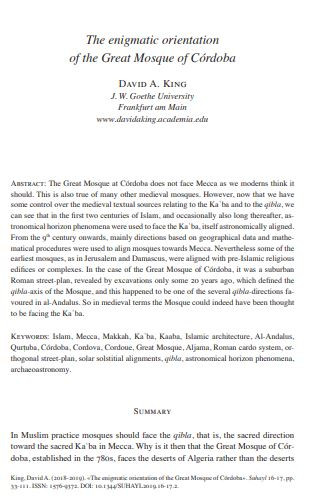
The Great Mosque at Córdoba does not face Mecca as we moderns think it
should. This is also true of many other medieval mosques. However, now that we have
some control over the medieval textual sources relating to the Kaʿba and to the qibla, we
can see that in the first two centuries of Islam, and occasionally also long thereafter, astronomical horizon phenomena were used to face the Kaʿba, itself astronomically aligned.
From the 9th century onwards, mainly directions based on geographical data and mathematical procedures were used to align mosques towards Mecca. Nevertheless some of the
earliest mosques, as in Jerusalem and Damascus, were aligned with pre-Islamic religious
edifices or complexes. In the case of the Great Mosque of Córdoba, it was a suburban
Roman street-plan, revealed by excavations only some 20 years ago, which defined the
qibla-axis of the Mosque, and this happened to be one of the several qibla-directions favoured in al-Andalus. So in medieval terms the Mosque could indeed have been thought
to be facing the Kaʿba.
I agree to the terms outlined below:
You agree to upload and assign Mosqpedia Database the rights to use the content worldwide and in perpetuity across all current and future media platforms. Mosqpedia Database may edit, copy, adapt and translate your contribution.
The content will be distributed under the Creative Commons Attribution-Deed – Attribution-NonCommercial-NoDerivatives 4.0 International – Creative Commons
All data will be stored in line with data protection regulations.